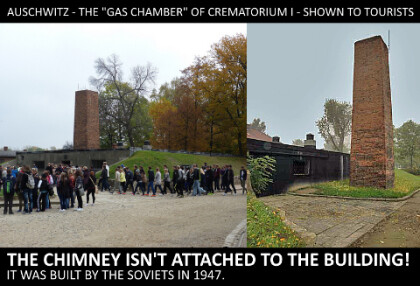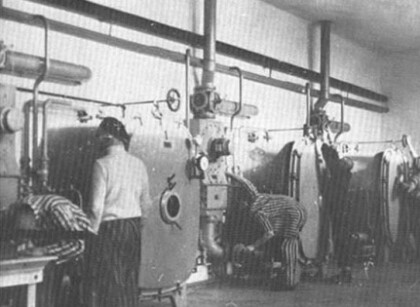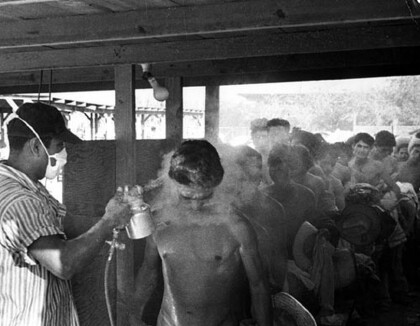The Truth about Germany and the World Wars by Terence Smart (recommended reading txt) 📖

- Author: Terence Smart
Book online «The Truth about Germany and the World Wars by Terence Smart (recommended reading txt) 📖». Author Terence Smart
Auschwitz even had its own maternity ward were thousands of babies were born. Stanislawa Leszczynska was a Polish midwife who was incarcerated at the Auschwitz concentration camp during World War 2 were she delivered over 3000 children. She is an official candidate for canonisation by the Catholic Church. Several hospitals and organisations in Europe are named after Stanislawa and the main road into the Auschwitz concentration camp museum is named after her. But the questions is if Auschwitz was a death camp then why was there a maternity ward and why was Stanislawa allowed to deliver over 3000 babies?
The Jews were vital to the German war industry. It would have been counter productive to exterminate them. In fact, the SS arrested Karl Koch, commandant of Buchenwald, for mistreating and unjustly executing some prisoners. After being found guilty by a military court, Koch was sentenced to death and shot. If there was actually a "holocaust" he would have been honoured instead of executed.
During the final year of the war the German cities and infrastructure was bombed intensely which meant getting supplies to the camps was extremely difficult. One of the much needed supplies was the Zyklon-B insecticide which was used to kill the lice on the inmates. The Allied bombardment of railroads and medicine factories contributed greatly to this shortage of Zyklon-B. The lice spread Typhus and without Zyklon-B a huge number of inmates in the camps began to die. Because of the contagious nature of typhus the corpses were cremated. The existence of a facility to hygienically dispose of bodies is, therefore, by itself no “proof” of an intention of mass murder. Most present-day prisons and hospitals also have in-house crematoria, which is a standard practice in any area of concentrated population. Typhus is known to spread in crowded conditions. During WW1 some 5 million Polish and Russian soldiers died of Typhus and thousands of Boer woman and children died of Typhus in the British concentration camps in South Africa. You could say that it was the Allies fault that these people in the camps died because of the intense bombing of the German infrastructure which the meant the camps did not get the supplies needed.
Jewish Holocaust storytellers say that Zyklon-B gas was used to kill them. Let us look at the truth below.
The first camp at Auschwitz was called Auschwitz I and it held Polish soldiers captured during the Polish campaign in 1939. It is important to note because the false belief has been created that only
Jews were interred in the concentration camps and they were primarily built to house political
prisoners prior to the outbreak of the war.
A report from Auschwitz on 28 October 1942 states that they were 25,298 inmates: 18,754 men and 6,544 women; including 10,755 Jews, 8,822 Poles, 1,369 Russians and 1,578 Germans. Notice that less than half of these people were Jews. Most people seem to think that there were only Jews in these camps but obviously this was false.
Labour was needed for the IG Farben industry and this workforce was supplied by the prisoners at Auschwitz. Many Russian prisoners were also sent here to work. Captain Rudolf Hoss was in charge of the camp which held at times about 30,000 inmates. As people died naturally or because of disease he needed a crematorium to dispose of the bodies.
. 
Above the chimney on the right was added after the war and is not even attached to the building. The Russians built this to maintain their fairy tale of the extermination of the Jews.
However another thing to note is that the original German architectural building plans that are on display at the camp museum show no plan for gas chambers!
To stop the spread of Typhus the Germans shaved the heads of the people in the camps and deloused them and their clothes in delousing chambers. It was from these shower facilities that the gassings story originated

Below workers at Auschwitz delousing the camp inmate’s clothes. This was the system used to kill the lice on the clothing which helped to stop the spread of Typhus.

Below a current picture of these same delousing chambers but with all the piping removed which was probably to cover up the real reason for these facilities

Below workers at the camp sorting clothes as part of the delousing process.

Below workers at the camp unloading clothes and linen that needs delousing outside the delousing gas chamber.

Below Mexican migrant workers been fumigated with Zyklon-B

Below a Jewish girl been sprayed with Zyklon-B to kill lice.

Auschwitz had no mass graves. The cremation of four million bodies would have left 15,000 tons of ash which was never found. Many tons of coal would have been necessary for such mass cremations. Initially, the Soviets told conflicting stories about how the six million perished in the camps under their control. At first they claimed that the inmates had been "steamed" to death. On December 5, 1945, a Communist judge issued the following "Accusation No. 6" against defendant Hans Frank at Nuremberg:
"A large boiler for the production of superheated steam was injected into the interior of the rooms. The doors are closed hermetically and the long asphyxiation of the victims by the steam begins. At the start, screams came from inside, they die down slowly; after 15 minutes, the executions are completed."
This story was not believable. It was then changed to allege that trucks were backed up to the "death chambers" and carbon monoxide gas was pumped into the rooms. This claim too was "forgotten" and the Soviets then charged that the Germans changed the "steam chambers" into "gas chambers."
Heinrich Himmler feared a typhus epidemic in the camps. Eastern European Jews were very unhygienic and were often blamed for the spread of typhus. On December 28, 1942, Himmler ordered that, "the death rate in the camps must be reduced at all costs." (Source, Reitlinger's book, The Final Solution.) On January 20, 1943, chief inspector of the camps, Richard Glucks, answered Himmler, "Every means will be used to lower the death rates." (Source, Nuremberg Trial Document No. 1523.) The death rate had indeed been reduced from 8.5% in July 1942 to 2.8% in June 1943. Again if he was trying to lower the death rates, why would he want to gas them, it does not make sense.
On December 15, 1942, Himmler, concerned about the high mortality of inmates in concentration camps, wrote the following letter to the head of the SS WVHA: “Dear Pohl, re our conversation in Hegewaldheim. In 1943, seek to acquire to a maximum extent for the inmates’ sustenance raw vegetables and onions. During the vegetable season, distribute large quantities of carrots, kohlrabi, turnips and as many other similar vegetables as are available, and store a sufficient quantity for the inmates in winter, so that inmates can receive a satisfactory amount of them every day. I believe that in this way we will significantly improve [their] state of health. Heil Hitler. Yours, Himmler.”
On December 28, 1942, Himmler ordered concentration camp inmate mortality to be reduced at any cost. On the same day, SS Brigade fuhrer Glucks sent concentration camp medical officers (camp physicians) a letter concerning “medical activity in the concentration camps.
Glücks continues:
“With a death rate so high, you can never bring the number of inmates up to the level that the Reichsfuhrer SS has ordered. The chief physicians in the camps must strive with all means at their disposal to ensure that the death rate in individual camps falls substantially. The best doctor in a concentration camp is not one who seeks to attract attention with inappropriate harshness, but one who maintains the labor capacity as high as possible with surveillance and rotation in individual workplaces. Camp medical officers have to attach more importance to monitoring inmates’ food and to make proposals for improvements to the camp commandants in agreement with the authorities. These must not, however, remain only on paper, but must be regularly checked by camp doctors. Camp doctors must also ensure that working conditions in individual workplaces are improved as much as possible. For this purpose, it is necessary that camp doctors check working conditions in person and on site. The Reichsführer SS has ordered that mortality absolutely must be reduced. For this reason, it is ordered as above, and each month a report must be submitted to the head of Office D II on what measures have been taken. Starting February 1, 1943”.
On January 20, 1943 Glucks replied to Himmler’s order and wrote to the concentration camp commandants as follows: “I forward for information the copy attached. As I have already pointed out, the mortality rate in the camps must be reduced by all available means. This is also possible with the full utilization and appetizing preparation of the food available, and good management of the reception of parcels. I hold the camp commandant and the head of the of the concentration camp administration personally responsible for exhausting every possibility to maintain the working capacity of the inmates, and will check in the future during staff assessments which must be submitted here whether in this case the SS officers responsible have fully performed their duty.” As a result of these measures taken by Himmler, in the first half of 1943 deaths in concentration camps dropped significantly. In the report on this by Pohl to Himmler, dated September 30, 1943, we read: “Reichsfuhrer, after mortality in December 1942 fell to about 10%, already in the month of January 1943 it dropped to 8%, and has since decreased steadily. In essence, this decline in mortality is due to the fact that hygiene measures requested for a long time have now been implemented at least to a large extend. Also, with regard to food, it has been ordered that a third of the nourishment, raw and properly chopped-up, be added to the cooked food just before serving.”
On October 26, 1944, in a letter to the commandants of KL Auschwitz III Glucks stated that: “Every inmate must be able to sleep at least 7½ -8 hours, if the following day he is to be at 100%. Attention must be paid specifically to ensuring that inmates employed on night shift, after returning from duty, can also sleep undisturbed the number of hours needed during the day, and their sleep must not be interrupted for roll calls.”
Other measures concerned the improvement of winter clothing, the shorter duration of roll calls, and the right to receive food parcels, and a cookery class in Dachau for inmate cooks.
On October 26, 1943 Pohl issued an important secret directive that concerned the improvement of inmates’ living conditions. This was sent to the commandants of 19 concentration camps, including Auschwitz.
“Within the framework of German war production, thanks to the construction work carried out during the past two years, concentration camps represent a factor of decisive strategic importance. We have created from nothing armaments factories that have no equal. Now we must act with all forces at our disposal so that the achievements realized so far are not only maintained, but furthermore steadily increased in the future. Since the workshops and factories are essentially set up, this is only possible by us maintaining the working strength of the inmates and further increasing it. In recent years, as part of the tasks of rehabilitation then in force, it might have been unimportant whether an inmate could or could not provide useful labor. But now the working strength of the inmates is important, and all measures of the commandants, the heads of Office V and the doctors must chiefly focus on maintaining the health and the productivity of the inmates. Not from hypocritical sentimentality, but because we need their arms and legs, because they have to contribute to the German people achieving a great victory. For this we need to take to heart the welfare of the inmates. As a first goal, I set this: no more than 10% of all inmates may be unfit for work due to illness. This objective must be achieved by a joint effort of all those responsible. For





Comments (0)